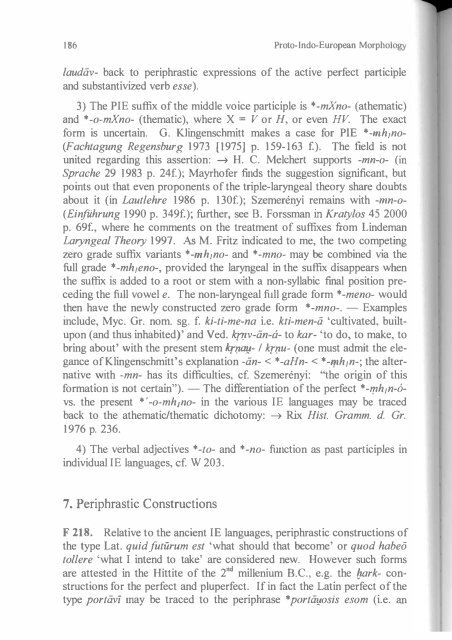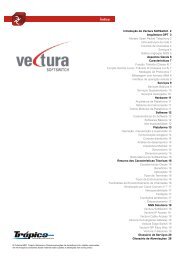Create successful ePaper yourself
Turn your PDF publications into a flip-book with our unique Google optimized e-Paper software.
186 Proto-Indo-European MorphologyVerbs187laudiiv- back to periphrastic expressions <strong>of</strong> the active perfect participleand substantivized verb esse).3) The PIE suffix <strong>of</strong> the middle voice participle is *-m.Xno- (athematic)and *-o-m.Xno- (thematic), where X = Vor H, or even RV. The exactform is uncertain. G. Klingenschmitt makes a case for PIE *-l1Ih,no(Fachtagung Regensburg 1973 [1975] p. 159-163 f.). The field is notunited regarding this assertion: H. C. Melchert supports -l1In-o- (inSwache 29 1983 p. 24f.); Mayrh<strong>of</strong>er finds the suggestion significant, butpomts out that even proponents <strong>of</strong> the triple-laryngeal theory share doubtsabout it (in Lautlehre 1986 p. 130f.); Szemerenyi remains with -l1In-o(Einfiihrung 1990 p. 349f.); further, see B. Forssman in Kratylos 45 2000p. 69f., where be comments on the treatment <strong>of</strong> suffixes from LindemanLaryngeal Theory 1997. As M. Fritz indicated to me, the two competingzero grade suffix variants *-l1Ih,no- and *-mno- may be combined via thefull grade *-mh,eno-, provided the laryngeal in the suffix disappears wbenthe suffix IS added to a root or stem with a non-syllabic final position precedingthe full vowel e. The non-laryngeal full grade form *-meno- wouldthen have the newly constructed zero grade form *-l1Ino-. - Examplesmclude, Myc. Gr. nom. sg. f. ki-ti-me-na i.e. kti-men-ii 'cultivated, builtupon(and thus inhabited)' and Ved. /q1Jv-iin-ti- to kar- 'to do, to make tobring about' with the present stem !crnctlj- / !crnu- (one must admit the Ieg ce <strong>of</strong> Klingenschmitt's explanation -iin- < *-aHn- < *-1[Ih,n-; the alternative.Wlth -mn- has its difficulties, cf. Szemerenyi: "the origin <strong>of</strong> thisformation IS not certain"). - The differentiation <strong>of</strong> the perfect *-mh,n-ovs.the present * '-o-mh/llo- in the various IE languages may t>e' tracedback to the athematic/thematic dichotomy: Rix Hist. Graml1l. d. Gr.1976 p. 236.4) The verbal adjectives *-to- and *-no- function as past participles inindividual IE languages, cf. W 203.7. Periphrastic ConstructionsF 218. Relative to the ancient IE languages, periphrastic constructions <strong>of</strong>the type Lat. quid futurum est 'what should that become' or quod habeotol/ere 'what I intend to take' are considered new. However such formsare attested in the Hittite <strong>of</strong> the 2"d millenium RC., e.g. the iJark- construCtionsfor the perfect and pluperfect. If in fact the Latin perfect <strong>of</strong> thetype portiivi may be traced to the periphrase *portii'1osis esom (i.e. anactive perfect participle with -'1OS- + verbum substantivum [cp. F 217 §2]), then also it must date from prehistoric period. Thus, it may not beruled out that Proto-Indo-European already featured several periphrasticconstructions.I also consider cases such as the following to be similar to paraphrases:Lat. vendere < venum *dide- 'to put up for sale,' in the sense <strong>of</strong> 'to sell'vs. venire < venum ire 'to go for sale' in tbe sense <strong>of</strong> 'to be sold' (didemusthere be traced to PIE *dheh,- and not to *deh,-!: Meiser Laut- u.Formenlehre 1998 p. 192). Or, similarly, interficere 'to separate (fromlife), to make disappear' in the sense <strong>of</strong> ' to kill' vs. interire 'to go and disappear'in the sense <strong>of</strong> 'to decline' (For details relative to inter: H.Hettrich in MSS 54 1993 p. 169-172; -facere makes clear that this is acase <strong>of</strong> PIE *dheh,-). This combination <strong>of</strong> substantivized verb or preverband *dheh,- (in tbe active sense), or *h,ei- 'to go' (in tbe passive sense)certainly dates from a pre-individual language period. For a further example,cf. F 207 § 2 with H. Eichner's reflections on the optative.Further sources: Rosen Periphrase 1992; Boley Hittite harkconstruction1984; Cotticelli-Kurras Hill. 'seill' 1991; by the same authors"The Hittite periphrastic constructions" in Grammatica illita 1992 p. 33-59; S. Luraghi "1 verbi ausiliari in ittita" in FS Ramat 1998 p. 299-322.C. Nouns and Adjectives1. General InformationF 300. Nouns as nominal members expand, complete, and clarify thecontent <strong>of</strong> the central verb form <strong>of</strong> the sentence. In contrast to verbs,nouns have a relatively limited number <strong>of</strong> forms. Through the basicmeaning <strong>of</strong> the word, which is contained in its nominal stem, the endingscommunicate information about the number and genre <strong>of</strong> the content, aswell as information about the role <strong>of</strong> the noun, which is assigned to it bythe speaker in the syntactical context, cf. S 400ff.F 301. Substantives and adjectives are closely related. This closeness isdemonstrated by the fact that an adjective can take the place <strong>of</strong> a substantive,e.g. Classical Gr. O KQKO" 'the bad' and Lat. IUna 'moon' « Proto-





